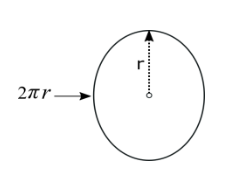
The Orbital speed of Jupiter is?
A) Greater than the orbital speed of earth
B) Less than the orbital speed of earth
C) Equal to the orbital speed of earth
D) Zero
Answer
570.3k+ views
Hint:To find the solution of this question we have to find the relation of orbital speed to the radius of orbital of planet with the help of Kepler's law of planetary motion.
We know that Jupiter is far away from the sun than Earth; it means Jupiter has a bigger orbit than earth.
Complete step by step solution:
Step 1 - We know all the planets move in a circular path around the sun.

By this we can find the orbital speed of any planet easily by applying formula
$v = \dfrac{{2\pi r}}{T}$ ........... (1)
This equation gives us the relation between orbital speed and time period of the planet.
Step 2 - We know third law of Kepler's law of planetary motion:
Square of time period directly proportional to the cube of radius of orbit.
${T^2} = k{r^3}$
$T = k{r^{\dfrac{3}{2}}}$ ............ (2)
Where T is time period of revolution
K is a constant
$r$ is the radius of orbit
This equation gives us the relation between the time period of revolution of any planet to the radius of orbit.
Step 3
Using equation 2 in equation 1
$
v{}_o = \dfrac{{2\pi r}}{{k{r^{\dfrac{3}{2}}}}} \\
{v_o} = \dfrac{{2\pi }}{{k\sqrt r }} \\
$
Finally we get a relation between orbital speed of planet and the radius of orbit
${v_o} \propto \dfrac{1}{{\sqrt r }}$
Clearly we can see that the orbital speed inversely proportional to the square root of radius of orbit
So we can say that the larger radius has less orbital speed and the smaller radius has greater orbital speed.
Since the distance of Jupiter from the sun is greater than the distance between the sun and the earth so that Jupiter has a larger radius of orbit then earth so Jupiter has less orbital speed then earth.
So option B is correct here.
Note: We see here as well as we go away from the sun the radius of orbit increases and the time period of revolution also increases.
And the orbital speed decreases as we go away from the sun.
It means the planet which is far away from the sun has less orbital speed.
We know that Jupiter is far away from the sun than Earth; it means Jupiter has a bigger orbit than earth.
Complete step by step solution:
Step 1 - We know all the planets move in a circular path around the sun.

By this we can find the orbital speed of any planet easily by applying formula
$v = \dfrac{{2\pi r}}{T}$ ........... (1)
This equation gives us the relation between orbital speed and time period of the planet.
Step 2 - We know third law of Kepler's law of planetary motion:
Square of time period directly proportional to the cube of radius of orbit.
${T^2} = k{r^3}$
$T = k{r^{\dfrac{3}{2}}}$ ............ (2)
Where T is time period of revolution
K is a constant
$r$ is the radius of orbit
This equation gives us the relation between the time period of revolution of any planet to the radius of orbit.
Step 3
Using equation 2 in equation 1
$
v{}_o = \dfrac{{2\pi r}}{{k{r^{\dfrac{3}{2}}}}} \\
{v_o} = \dfrac{{2\pi }}{{k\sqrt r }} \\
$
Finally we get a relation between orbital speed of planet and the radius of orbit
${v_o} \propto \dfrac{1}{{\sqrt r }}$
Clearly we can see that the orbital speed inversely proportional to the square root of radius of orbit
So we can say that the larger radius has less orbital speed and the smaller radius has greater orbital speed.
Since the distance of Jupiter from the sun is greater than the distance between the sun and the earth so that Jupiter has a larger radius of orbit then earth so Jupiter has less orbital speed then earth.
So option B is correct here.
Note: We see here as well as we go away from the sun the radius of orbit increases and the time period of revolution also increases.
And the orbital speed decreases as we go away from the sun.
It means the planet which is far away from the sun has less orbital speed.
Recently Updated Pages
Why are manures considered better than fertilizers class 11 biology CBSE

Find the coordinates of the midpoint of the line segment class 11 maths CBSE

Distinguish between static friction limiting friction class 11 physics CBSE

The Chairman of the constituent Assembly was A Jawaharlal class 11 social science CBSE

The first National Commission on Labour NCL submitted class 11 social science CBSE

Number of all subshell of n + l 7 is A 4 B 5 C 6 D class 11 chemistry CBSE

Trending doubts
What is meant by exothermic and endothermic reactions class 11 chemistry CBSE

10 examples of friction in our daily life

One Metric ton is equal to kg A 10000 B 1000 C 100 class 11 physics CBSE

1 Quintal is equal to a 110 kg b 10 kg c 100kg d 1000 class 11 physics CBSE

Difference Between Prokaryotic Cells and Eukaryotic Cells

What are Quantum numbers Explain the quantum number class 11 chemistry CBSE




